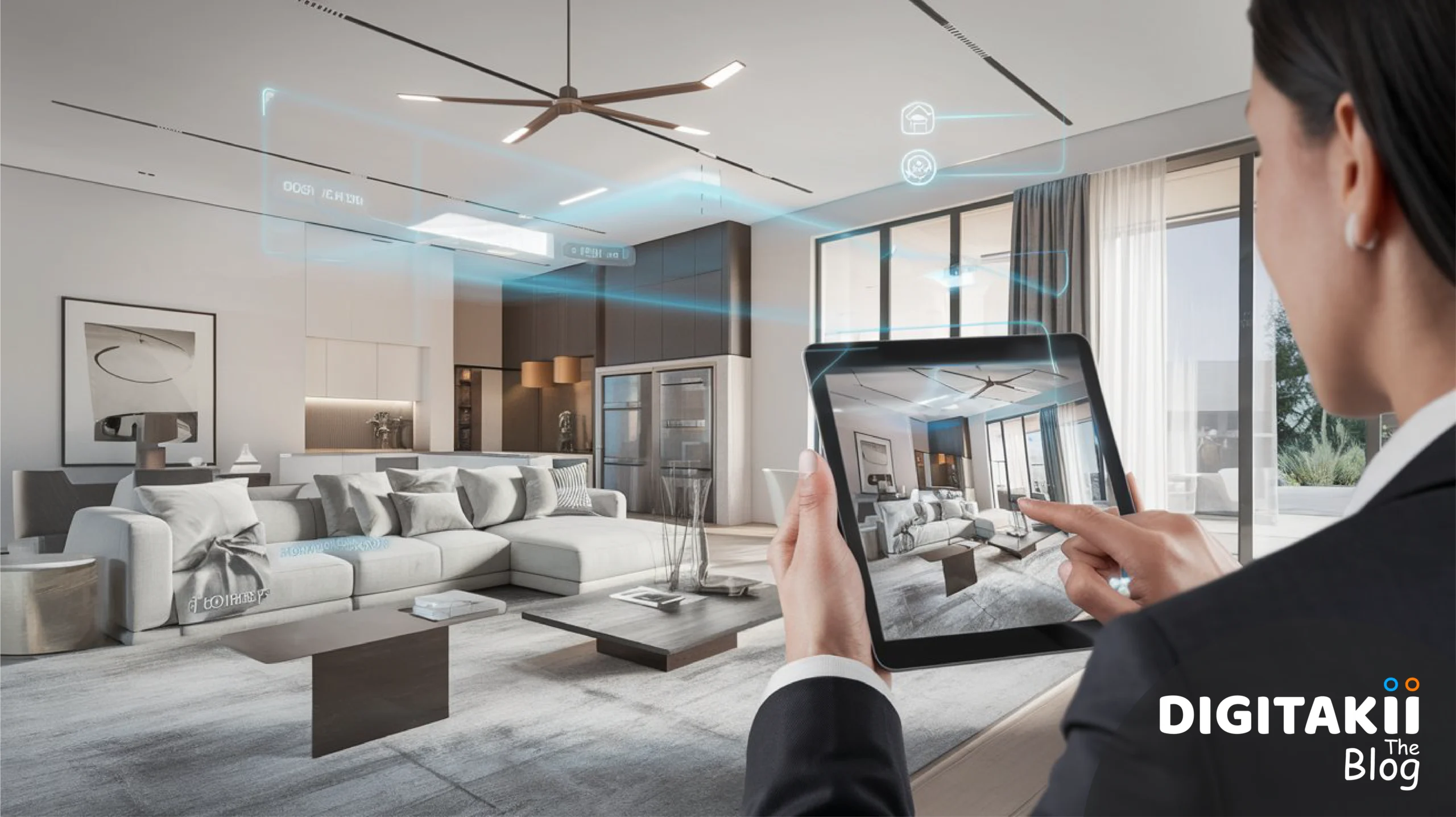Imagine walking through your future home without leaving the couch. Sounds like science fiction? It’s not. Augmented reality (AR) marketing is transforming the real estate industry by creating immersive, interactive experiences for potential buyers. If you’re a real estate agent or developer looking to leverage AR in your marketing strategy, this guide will delve into how AR is reshaping real estate marketing and why it’s a game changer.
1. What is Augmented Reality in Real Estate?
Augmented reality (AR) integrates digital information with the real world in real-time. Unlike virtual reality (VR), which creates a completely digital environment, AR overlays digital elements onto the real world. In real estate, this means potential buyers can see virtual home features, furniture, or renovations in their actual space through a mobile device or AR glasses.
2. Why AR is a Game-Changer for Real Estate Marketing
2.1 Enhancing Property Visualization
AR allows buyers to visualize properties more vividly. Instead of imagining how a room might look with different furniture, buyers can see it instantly through their devices. This helps in making informed decisions and speeds up the buying process.
2.2 Personalizing the Buying Experience
AR can create customized experiences based on the buyer’s preferences. From choosing paint colors to rearranging furniture, AR lets buyers personalize their potential homes, making the experience more engaging.
2.3 Improving Remote Viewings
For out-of-town buyers or those with busy schedules, AR enables remote property tours. Potential buyers can explore properties from the comfort of their own home, increasing the reach and convenience of viewings.
3. How to Implement AR in Real Estate Marketing
3.1 Partner with AR Technology Providers
Collaborate with AR technology companies to integrate AR features into your marketing strategy. These providers offer the necessary tools and expertise to create effective AR experiences.
3.2 Develop Interactive Property Listings
Enhance your property listings with AR elements. Include features like 360-degree tours, virtual staging, and interactive floor plans to give potential buyers a comprehensive view of the property.
3.3 Utilize AR for Virtual Open Houses
Host virtual open houses using AR technology. This allows buyers to explore the property interactively and ask questions in real-time, simulating an in-person experience.
4. Examples of Successful AR Marketing in Real Estate
4.1 Virtual Home Staging
Companies like Homestyler and Modsy use AR to stage homes virtually. Buyers can see different furniture layouts and decor options, helping them visualize how they would live in the space.
4.2 Interactive Property Maps
AR applications like Matterport provide interactive maps of properties. Users can navigate through different rooms, view property features, and even measure spaces using their devices.
4.3 AR Real Estate Apps
Apps like Zillow and Redfin are incorporating AR to allow users to point their smartphones at a property and view detailed information, such as market value and neighborhood stats, overlaid on their screen.
5. The Benefits of AR Marketing for Real Estate
5.1 Increased Engagement
AR captures attention and engages users more effectively than traditional marketing methods. Interactive experiences are more memorable and can lead to higher conversion rates.
5.2 Enhanced Buyer Experience
AR provides a more immersive and informative experience, helping buyers make more confident decisions. The ability to visualize changes and personalize spaces adds significant value.
5.3 Competitive Edge
Adopting AR technology can set your real estate business apart from competitors. It demonstrates innovation and a commitment to providing cutting-edge services.
6. Challenges and Considerations
6.1 Cost of Implementation
Implementing AR technology can be expensive. It’s essential to weigh the potential return on investment and plan your budget accordingly.
6.2 Technology Adoption
Not all buyers are familiar with AR technology. Ensuring ease of use and providing support can help in overcoming this challenge.
6.3 Data Privacy
With the use of AR, managing and protecting user data is crucial. Ensure compliance with privacy regulations and implement robust security measures.
7. Future Trends in AR Real Estate Marketing
7.1 Advanced AI Integration
The integration of artificial intelligence (AI) with AR can further enhance the personalization of real estate marketing. AI can analyze user preferences and provide tailored AR experiences.
7.2 Improved AR Hardware
As AR technology evolves, more sophisticated and affordable hardware will become available, making it easier for both businesses and consumers to use AR effectively.
7.3 Greater Interactivity
Future AR applications will likely offer even more interactive features, such as virtual reality integration and real-time updates, enhancing the overall user experience.
8. Tips for Using AR Effectively in Real Estate Marketing
8.1 Know Your Audience
Understand your target audience’s tech-savviness and preferences to tailor your AR experiences accordingly.
8.2 Invest in Quality Content
High-quality AR content is crucial for creating an engaging experience. Invest in professional-grade visuals and interactive elements.
8.3 Promote Your AR Features
Make sure potential buyers are aware of your AR offerings. Highlight these features in your marketing materials and property listings.
9. Case Studies of AR Success in Real Estate
9.1 Case Study 1: Zillow
Zillow successfully used AR to enhance their property listings, leading to a significant increase in engagement and sales.
9.2 Case Study 2: Matterport
Matterport implemented AR virtual tours, allowing remote buyers to explore properties more effectively and closing deals faster.
10. Conclusion
Augmented reality marketing is revolutionizing the real estate industry by offering immersive, interactive, and personalized experiences for buyers. By implementing AR effectively, real estate professionals can enhance property visualization, engage buyers, and gain a competitive edge. As AR technology continues to evolve, its potential to transform real estate marketing is boundless.
FAQs
1. What is augmented reality (AR) in real estate?
AR in real estate involves overlaying digital information, such as virtual home features or furniture, onto the real world. This helps potential buyers visualize properties more vividly.
2. How can AR enhance the property buying experience?
AR enhances the buying experience by allowing buyers to see virtual changes, such as different furniture layouts or paint colors, in real-time, making it easier to make informed decisions.
3. What are the benefits of using AR in real estate marketing?
AR increases engagement, enhances the buyer experience, and provides a competitive edge by offering interactive and personalized property tours.
4. What challenges should be considered when implementing AR in real estate?
Challenges include the cost of implementation, varying levels of technology adoption among buyers, and ensuring data privacy and security.
5. How can real estate businesses effectively use AR?
Real estate businesses should understand their audience, invest in high-quality AR content, and promote their AR features to maximize the effectiveness of their AR marketing efforts.
#AugmentedReality #RealEstateMarketing #PropTech #VirtualTours #ARinRealEstate #HomeBuying #PropertyTechnology #InteractiveMarketing #RealEstateInnovation #DigitalRealEstate #VirtualHomeStaging #FutureOfRealEstate #3DPropertyTours #RealEstateTrends #ARMarketing #Digitakii #DigitakiiTheBlog
===============================
Ready to dominate the digital world? 🚀💻
Don’t just exist online – THRIVE! At www.digitakii.com, we’re your secret weapon for digital success.
🌐 Stunning websites that convert 📱 Social media that sizzles 🔍 SEO that skyrockets your visibility 📊 Data-driven strategies for real results
Why blend in when you can stand out? Let’s craft your digital masterpiece together!
👉 Visit www.digitakii.com now and let’s make some digital magic! ✨
#DigitalMarketing #DigitalPresence #DigitalMarketingAgency
===============================



